
The Dome on George Street may be Party Central these days, but it was not always so.
Where now stands a temple of food, drink, high heels and all things bubbling over with Christmassy-ness, there stood first a temple of Science and then another of Capitalism.
Designed by David Rhind and begun in 1844, today's building replaced a smaller classically influenced Physicians' Hall erected in 1775 to the plans of James Craig – the architect of the first New Town. The engraving below featured in Thomas Shepherd's Modern Athens (1829).
James Grant (Old and New Edinburgh, 1880: Vol. 3) described the interior: 'The sunk floor, which was all vaulted, contained rooms for the librarian and other officials; the entrance floor consisted of four great apartments opening from a noble vestibule, with a centre of thirty-five feet: one was for the ordinary meetings of the college, and another was an ante-chamber; but the principal apartment was the library—a room upwards of fifty feet long by thirty broad, lighted by two rows of windows, five in each row, facing Rose Street, and having a gilded gallery on three sides.'
Craig's building won plaudits at the time, but was impractical within as a teaching institution and had proved more expensive than expected to complete (£4,800), leaving the College of Physicians out of pocket.
It was a bitter pill to swallow, but in 1843 they sold the property to the Commercial Bank for £20,000.
[img_assist|nid=3639|title=|desc=|link=node|align=center|width=640|height=351]The next year, the Commercial Bank tore down the original and set about making a statement that was intended to be both in the best possible taste and significantly more eye-boggling than the Royal Bank of Scotland's Head Office in St Andrew Square.
Rhind's structure – opened in 1847 – is Graeco-Roman in style, with a Corinthian portico drawing heavily from Willaim Henry Playfair's design for the Surgeon's Hall on Nicolson Street. The betinselled columns may subtly allude to the staff and serpent of Aesculapius, God of Healing, but did not feature in the architect's plan.
Figures above the pediment represent Caledonia at the centre of Agriculture, Commerce, Enterprise, Mechanical Science, Learning and Prudence. If one were starting afresh today, perhaps one would prefer to see Kylie flanked by Debt, Materialism, Banality, Hedonism, Ignorance and Incuriosity. Or perhaps not. Season's greetings.
The Commercial Bank merged with The National Bank of Scotland Ltd in 1959, and – in a ghastly paradox – the hybrid was itself subsumed under its former rival the Royal Bank of Scotland ten years later. It continued as a branch – its pretensions preposterously out of proportion to its purpose – until 1993 when it was sold to Caledonian Heritable Ltd who converted the premises to their current use.
Our image top-right comes courtesy of Mark Johnstone, a professional freelance photographer and local resident whom we first featured during his solo exhibition at McDonald Road Library last year (Breaking news, 20.9.12). You can see more of his work for sale here.